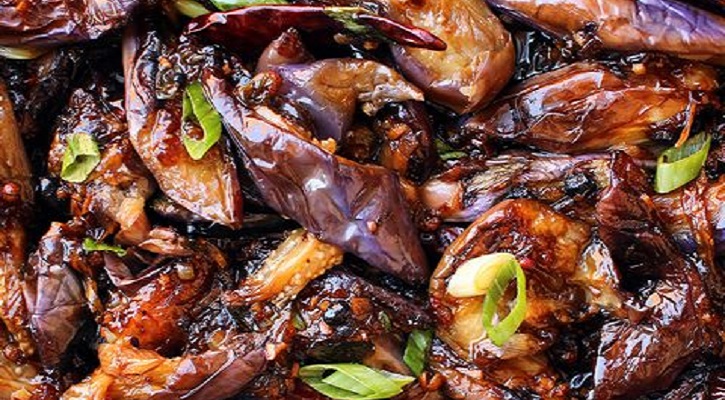
Sichuan-Style "Fish-Fragrant" Eggplant
- Women`s Corner
- October 18, 2022
Despite the name, there is no trace of fish in this delicious eggplant dish. Originating from the Sichuan province in China, 魚香 (yu xiang) literally means "fish fragrance" and describes a flavor profile that was originally used in preparing fish dishes from the region. Usually involving pickled chilis, fermented bean paste, green onions, garlic, ginger, this potently punchy but harmoniously savory spice combination grew in popularity and is now used to season vegetable stir-fries and meat stews alike.
Savory Sichuan cuisine is often characterized by impeccable wok stir-fry technique, involving super high heat and fast-actioned tossing that ensures perfect, even cooking. To approximate the distinctive aromas and textures at home, follow our tips below for making a mighty eggplant stir-fry with your humble stovetop.
Choosing your oil
For searing the eggplant and stir frying the sauce, use animal fat, like lard or schmaltz, if you want to really heighten the savory flavors in this dish to the max. Peanut oil can be great for a little hint of nuttiness, but any vegetarian cooking oil—like canola—will work perfectly fine. No matter what cooking oil you choose to use, we recommend also adding a couple of teaspoons of toasted sesame oil towards the end of the cooking process to up the fragrance factor.
Read More: Indian Stir-Fried Prawns
Choosing your eggplant
While you can use any variety of eggplant for this dish, it's traditionally made with Chinese eggplants. Longer and sleeker in shape than the ubiquitous globe eggplant of North America, its skin is thinner and its flesh is finer and silkier when cooked. If you can get your hands on Chinese eggplants, use 'em! After slicing your eggplant into large two-biter pieces, be sure to toss them evenly with kosher salt and let them sit for 20 to 30 minutes in order to draw out the moisture from within: This process will help tenderize the eggplant and achieve that creaminess we're after.
To make this dish without deep-frying the eggplant in a wok over a roaring hot flame at home, we're tossing the eggplant in cornstarch before pan-searing it in batches. Maintain a solid medium heat, keep the bottom of the pan coated with a thin layer of oil at all times, and toss the eggplant every minute or so until even golden color develops across each piece. This step par-cooks the eggplants so that they're softened but still holding their shape. When the eggplants later return to the pan to finish cooking to perfect tenderness, the sauce will thicken to a glossy consistency and coat each piece of eggplant as the cornstarch gradually melts into the dish.
Read More: Kidney Beans Sandwich with Cottage Cheese Recipe
How spicy do you like it?
While Sichuanese cuisine has gained a reputation for extraordinary levels of spiciness, the emphasis of fish-fragrant eggplant is on the "fragrant" (香). Traditionally, this dish is made with a special variety of Sichuan pickled peppers and a specific fermented broad bean paste called doubanjiang. Lee Kum Kee retails a couple of different chili bean sauces and fermented black bean sauces, which is probably as close to the original Pixian variety as we can get in North America. To approximate the pickled peppers, I chose to substitute in sambal oelek (usually found on the shelf where Sriracha lives), but you can also use fresh, thinly sliced Thai chilis.
To add a different layer of flavor and heat, I'm also using ground Sichuan peppercorns for that tingly numbing spice sensation, as well as some dried chilis for a faint smokiness. These are both optional, but if you live for Scoville-fueled adrenaline rushes, don't skip 'em. For super spicy results, cut the dried chilis open to release the seeds; for flavor with less heat, keep them whole and avoid chewing on them when eating the dish!
A tale of two vinegars
We're using both rice wine vinegar and Chinese black vinegar (also known as Chinkiang vinegar), but if you can't find the latter, just use more of the former. Rice wine vinegar is sweeter and brighter tasting, and the black vinegar adds a deeper, molasses-like, almost-medicinal acidity. The two play together well to create a mellow blend of fresh and earthy tones.
Read More: Spiced Baby Potato Salad Recipe
It can be vegetarian!
Some versions of fish-fragrant eggplant contains minced pork for added richness and umami, but our version does not. While we do use chicken broth in the sauce, you could substitute vegetable broth or water for a completely vegan version. While chicken broth will add extra umami, there's a lot of other delicious seasonings in the dish (including an entire head of garlic, yes) to carry you through to eggplant paradise.
A word on MSG
If you don't have it on hand, or simply don't want to use it, feel free to leave it out! I find that MSG adds a nice, rounded savory flavor that's not quite salty, not quite sweet, and not quite funky—hard to pinpoint, but really magical as a mystery spice. It's often found in the seasoning mix in all of my favorite packaged chips, so it's no wonder I love the stuff. Between the 20-minute express salt-cure, the soy sauce, and the bean paste, there's already a good amount of sodium kicking around in the recipe, but taste as you go and add a pinch of salt if you want that flavor to hit your preferred salt levels.
This dish pairs extremely well with steamed rice, and tastes even better the next day: store leftovers in an airtight container in the fridge and eat it cold or hot, your choice. If you've made this recipe, drop us a line down below in the comments, leave us a rating, and let us know how you liked it! If you're in love with eggplants now, our recipes for baked eggplant parm and grilled eggplant await!
Read More: Kalan Kerala Curry Recipe
Ingredients:
- 3 Chinese eggplants (about 1 1/4 lb.), halved lengthwise and cut into thick diagonal strips
- 2 tsp. kosher salt
- 3 tbsp. cornstarch
- Canola oil
- 1 tsp. ground Sichuan peppercorn (optional)
- 6 to 12 dried red chilis (optional)
- 1 tbsp. chopped pickled chili, sambal oelek, or freshly sliced Thai chilis
- 3 tbsp. fermented chili bean paste
- 1 head garlic, minced, divided
- 1 tbsp. minced fresh ginger
- 1/2 tsp. ground white pepper
- 3 green onions, thinly sliced, divided
Read More: Raw Banana Kebab Recipe
- 1 1/2 tbsp. low-sodium soy sauce
- 1 1/2 tbsp. rice wine vinegar
- 2 tsp. Chinese black vinegar
- 4 tsp. granulated sugar
- 1/2 tsp. MSG (optional)
- 1/2 c. water or low-sodium chicken broth
- 2 tsp. toasted sesame oil
- Cooked rice, for serving
Method: In a large bowl, toss eggplant evenly with salt. Let sit for 20 to 30 minutes, then gently squeeze out as much moisture as possible. Drain and pat dry with a paper towel. Transfer to a dry bowl or sheet tray, then add cornstarch and toss to coat eggplant evenly. In a large skillet over medium heat, heat skillet for 1 minute, then heat 2 tablespoons oil until it starts to smoke slightly. Working in batches to avoid overcrowding the pan, fry eggplant until lightly golden on all sides, 3 to 4 minutes. Transfer to a bowl and set aside. Repeat with remaining eggplants, adding more oil as necessary if pan begins to run dry.
Read More: Pork souvlaki with Greek salad & rice
Return empty skillet to medium-low heat and add 2 more tablespoons oil. Add Sichuan peppercorn, chilis, bean paste, half the garlic, ginger, white pepper, and half the green onions. Stirring constantly, cook until fragrant and garlic is barely golden, about 1 minute.
Return eggplants to skillet. Pour in soy sauce, vinegars, sugar, MSG (if using), and water or broth, stirring occasionally until mixture thickens and becomes glossy. Stir in sesame oil, remaining garlic, and remaining green onions in the final minute of cooking.
Serve with rice, if desired.
This recipe is taken from https://www.delish.com/cooking/








